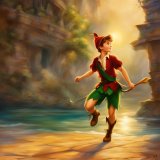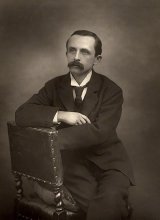Peter Pan Page #2
Peter Pan; or, the Boy Who Wouldn't Grow Up or Peter and Wendy is J. M. Barrie's most famous work, in the form of a 1904 play and a 1911 novel.
Mrs. Darling first heard of Peter when she was tidying up her children's minds. It is the nightly custom of every good mother after her children are asleep to rummage in their minds and put things straight for next morning, repacking into their proper places the many articles that have wandered during the day. If you could keep awake (but of course you can't) you would see your own mother doing this, and you would find it very interesting to watch her. It is quite like tidying up drawers. You would see her on her knees, I expect, lingering humorously over some of your contents, wondering where on earth you had picked this thing up, making discoveries sweet and not so sweet, pressing this to her cheek as if it were as nice as a kitten, and hurriedly stowing that out of sight. When you wake in the morning, the naughtiness and evil passions with which you went to bed have been folded up small and placed at the bottom of your mind and on the top, beautifully aired, are spread out your prettier thoughts, ready for you to put on. I don't know whether you have ever seen a map of a person's mind. Doctors sometimes draw maps of other parts of you, and your own map can become intensely interesting, but catch them trying to draw a map of a child's mind, which is not only confused, but keeps going round all the time. There are zigzag lines on it, just like your temperature on a card, and these are probably roads in the island, for the Neverland is always more or less an island, with astonishing splashes of colour here and there, and coral reefs and rakish-looking craft in the offing, and savages and lonely lairs, and gnomes who are mostly tailors, and caves through which a river runs, and princes with six elder brothers, and a hut fast going to decay, and one very small old lady with a hooked nose. It would be an easy map if that were all, but there is also first day at school, religion, fathers, the round pond, needle-work, murders, hangings, verbs that take the dative, chocolate pudding day, getting into braces, say ninety-nine, three-pence for pulling out your tooth yourself, and so on, and either these are part of the island or they are another map showing through, and it is all rather confusing, especially as nothing will stand still. Of course the Neverlands vary a good deal. John's, for instance, had a lagoon with flamingoes flying over it at which John was shooting, while Michael, who was very small, had a flamingo with lagoons flying over it. John lived in a boat turned upside down on the sands, Michael in a wigwam, Wendy in a house of leaves deftly sewn together. John had no friends, Michael had friends at night, Wendy had a pet wolf forsaken by its parents, but on the whole the Neverlands have a family resemblance, and if they stood still in a row you could say of them that they have each other's nose, and so forth. On these magic shores children at play are for ever beaching their coracles [simple boat]. We too have been there; we can still hear the sound of the surf, though we shall land no more. Of all delectable islands the Neverland is the snuggest and most compact, not large and sprawly, you know, with tedious distances between one adventure and another, but nicely crammed. When you play at it by day with the chairs and table-cloth, it is not in the least alarming, but in the two minutes before you go to sleep it becomes very real. That is why there are night-lights. Occasionally in her travels through her children's minds Mrs. Darling found things she could not understand, and of these quite the most perplexing was the word Peter. She knew of no Peter, and yet he was here and there in John and Michael's minds, while Wendy's began to be scrawled all over with him. The name stood out in bolder letters than any of the other words, and as Mrs. Darling gazed she felt that it had an oddly cocky appearance. “Yes, he is rather cocky,” Wendy admitted with regret. Her mother had been questioning her. “But who is he, my pet?” “He is Peter Pan, you know, mother.” At first Mrs. Darling did not know, but after thinking back into her childhood she just remembered a Peter Pan who was said to live with the fairies. There were odd stories about him, as that when children died he went part of the way with them, so that they should not be frightened. She had believed in him at the time, but now that she was married and full of sense she quite doubted whether there was any such person. “Besides,” she said to Wendy, “he would be grown up by this time.” “Oh no, he isn't grown up,” Wendy assured her confidently, “and he is just my size.” She meant that he was her size in both mind and body; she didn't know how she knew, she just knew it. Mrs. Darling consulted Mr. Darling, but he smiled pooh-pooh. “Mark my words,” he said, “it is some nonsense Nana has been putting into their heads; just the sort of idea a dog would have. Leave it alone, and it will blow over.” But it would not blow over and soon the troublesome boy gave Mrs. Darling quite a shock. Children have the strangest adventures without being troubled by them. For instance, they may remember to mention, a week after the event happened, that when they were in the wood they had met their dead father and had a game with him. It was in this casual way that Wendy one morning made a disquieting revelation. Some leaves of a tree had been found on the nursery floor, which certainly were not there when the children went to bed, and Mrs. Darling was puzzling over them when Wendy said with a tolerant smile: “I do believe it is that Peter again!” “Whatever do you mean, Wendy?” “It is so naughty of him not to wipe his feet,” Wendy said, sighing. She was a tidy child. She explained in quite a matter-of-fact way that she thought Peter sometimes came to the nursery in the night and sat on the foot of her bed and played on his pipes to her. Unfortunately she never woke, so she didn't know how she knew, she just knew. “What nonsense you talk, precious. No one can get into the house without knocking.” “I think he comes in by the window,” she said. “My love, it is three floors up.” “Were not the leaves at the foot of the window, mother?” It was quite true; the leaves had been found very near the window. Mrs. Darling did not know what to think, for it all seemed so natural to Wendy that you could not dismiss it by saying she had been dreaming. “My child,” the mother cried, “why did you not tell me of this before?” “I forgot,” said Wendy lightly. She was in a hurry to get her breakfast. Oh, surely she must have been dreaming. But, on the other hand, there were the leaves. Mrs. Darling examined them very carefully; they were skeleton leaves, but she was sure they did not come from any tree that grew in England. She crawled about the floor, peering at it with a candle for marks of a strange foot. She rattled the poker up the chimney and tapped the walls. She let down a tape from the window to the pavement, and it was a sheer drop of thirty feet, without so much as a spout to climb up by.
Translation
Translate and read this book in other languages:
Select another language:
- - Select -
- 简体中文 (Chinese - Simplified)
- 繁體中文 (Chinese - Traditional)
- Español (Spanish)
- Esperanto (Esperanto)
- 日本語 (Japanese)
- Português (Portuguese)
- Deutsch (German)
- العربية (Arabic)
- Français (French)
- Русский (Russian)
- ಕನ್ನಡ (Kannada)
- 한국어 (Korean)
- עברית (Hebrew)
- Gaeilge (Irish)
- Українська (Ukrainian)
- اردو (Urdu)
- Magyar (Hungarian)
- मानक हिन्दी (Hindi)
- Indonesia (Indonesian)
- Italiano (Italian)
- தமிழ் (Tamil)
- Türkçe (Turkish)
- తెలుగు (Telugu)
- ภาษาไทย (Thai)
- Tiếng Việt (Vietnamese)
- Čeština (Czech)
- Polski (Polish)
- Bahasa Indonesia (Indonesian)
- Românește (Romanian)
- Nederlands (Dutch)
- Ελληνικά (Greek)
- Latinum (Latin)
- Svenska (Swedish)
- Dansk (Danish)
- Suomi (Finnish)
- فارسی (Persian)
- ייִדיש (Yiddish)
- հայերեն (Armenian)
- Norsk (Norwegian)
- English (English)
Citation
Use the citation below to add this book to your bibliography:
Style:MLAChicagoAPA
"Peter Pan Books." Literature.com. STANDS4 LLC, 2024. Web. 21 Dec. 2024. <https://www.literature.com/book/peter_pan_12>.




Discuss this Peter Pan book with the community:
Report Comment
We're doing our best to make sure our content is useful, accurate and safe.
If by any chance you spot an inappropriate comment while navigating through our website please use this form to let us know, and we'll take care of it shortly.
Attachment
You need to be logged in to favorite.
Log In